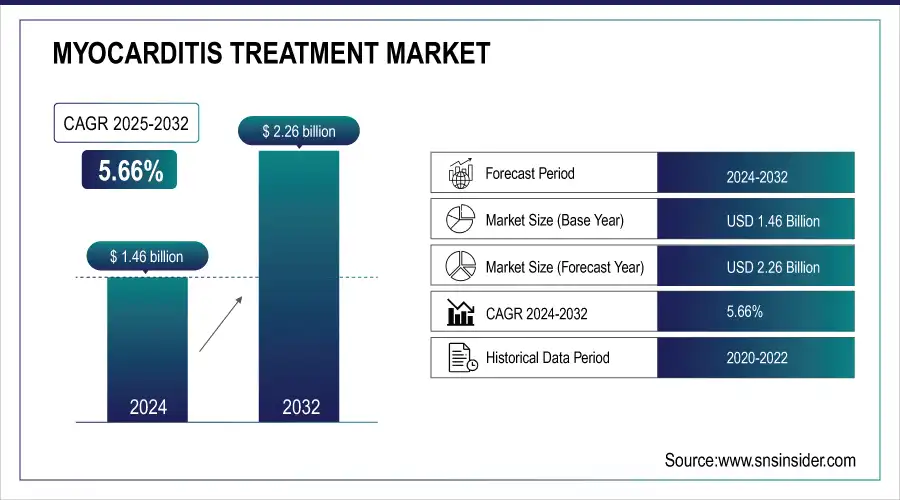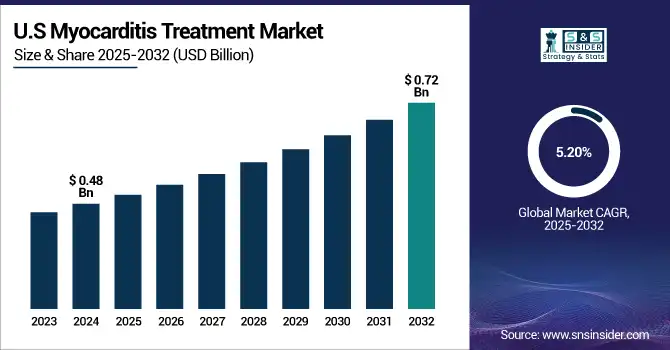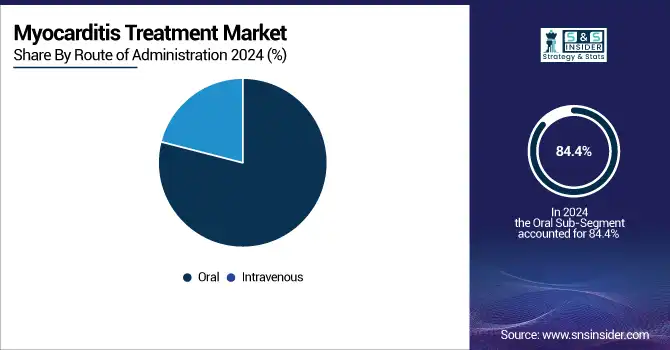Myocarditis Treatment Market Report Size Analysis:
The Myocarditis Treatment Market size was valued at USD 1.46 billion in 2024 and is expected to reach USD 2.26 billion by 2032, growing at a CAGR of 5.66% over the forecast period of 2025-2032.
The myocarditis treatment market is growing steadily due to the rise in viral infections, heightened awareness of inflammatory heart conditions, and the advancement of diagnostic technologies.
For instance, according to NCBI, Myocarditis is estimated to occur in approximately 1.5 million people worldwide annually, although the actual incidence is unknown and probably underestimated because of heterogeneity in presentation and lack of availability of sophisticated diagnostic facilities. The increased access to targeted therapies and supportive clinical trials, including the assessment of immunomodulatory drugs, is broadening treatment avenues.

To Get more information on Myocarditis Treatment Market - Request Free Sample Report
The U.S. myocarditis treatment market size was valued at USD 0.48 billion in 2024 and is expected to reach USD 0.72 billion by 2032, growing at a CAGR of 5.20% over the forecast period of 2025-2032. The U.S. has a stronghold in the North American myocarditis treatment market, due to its sophisticated healthcare infrastructure, a high degree of research activity, and a high incidence of cardiovascular diseases. The U.S. has the biggest patient pool for myocarditis, due to the extensive availability of state-of-the-art diagnostics and an active pipeline of therapeutic research. Large pharmaceutical groups, such as Pfizer and Bristol-Myers Squibb, are heavily involved in clinical trials and commercialization of new therapies, further demonstrating the nation's leadership in this field.

Myocarditis Treatment Market Dynamics:
Drivers
-
Increasing Rate of Viral and Post-Viral Myocarditis Is Driving the Market Growth
Myocarditis is most often caused by viral infections, and over the past few years, the incidence of these infections has gone up tremendously. Coxsackievirus, adenovirus, influenza, and SARS-CoV-2 (COVID-19) are some of the common causes of viral myocarditis. With the pandemic outbreak of COVID-19, doctors noticed an increased incidence of myocarditis, particularly post-infection and even post-vaccination in a very few cases.
Myocarditis occurs in about 1–10 cases per 100,000 per year, with some quoting as high as 22 per 100,000. The condition is significantly more common in men between 20 and 40 years of age.
This growing trend has boosted the need for proper diagnostics and efficient treatments. The cardiac complications of viral infections have also gained public and clinical attention, which has led to quicker detection, diagnosis, and treatment procedures. With these cases more and more reported and explained, health systems are spending more on managing and treating myocarditis, driving market growth.
-
Advances in Diagnostic Technologies are Propelling the Market Growth
Timely and precise diagnosis is pivotal in the effective treatment of myocarditis, and technological advances have greatly contributed to this endeavor. Cardiac magnetic resonance imaging (MRI) is a gold standard for non-invasive diagnosis, offering precise visualization of myocardial inflammation and fibrosis.
Other diagnostic equipment, such as echocardiography, electrocardiograms (ECG), biomarker tests (such as troponin, CRP, ESR), and endomyocardial biopsy, enables physicians to distinguish myocarditis from other cardiac disorders, such as myocardial infarction. These advances have enabled early diagnosis of the condition, facilitating timely intervention and specific treatment. As more healthcare facilities embrace these technologies around the world, the rate of diagnosing myocarditis improves, propelling the demand for successful treatments and playing a crucial role in expanding the market.
Restraint
-
Lack of Standardized Treatment Protocols Challenging the Market to Grow
Despite progress in the knowledge of myocarditis, the disease is still challenging with its pleomorphic etiologies and clinical manifestations. This makes treatment inconsistent between institutions and geographic locations. A systematic analysis of clinical practice guidelines identified inconsistencies in recommendations, especially regarding the role of endomyocardial biopsy and immunosuppressive medications, mostly based on expert opinion without strong clinical trial evidence.
For Instance, according to PubMed, the European Society of Cardiology 2021 and 2022 guidelines tried to unify myocarditis management but accepted the necessity of individualized disease management strategies concerning disease severity and patient-specific parameters.
Also, the American College of Cardiology 2024 consensus underlined personalized treatment but noted the absence of large-scale, randomized controlled trials to validate uniform treatment approaches.
This lack of standardized procedures results in patient care variability and creates challenges for healthcare professionals in making decisions, ultimately affecting the overall success of myocarditis treatment and hindering market growth.
Myocarditis Treatment Market Segmentation Analysis:
By Route of Administration
The oral segment dominated the market with 84.4% market share in 2024, buoyed by the rising number of patients shifting from inpatient to outpatient settings. Oral drugs, such as beta-blockers, ACE inhibitors, and maintenance corticosteroids, are generally prescribed for long-term control of chronic myocarditis or post-acute recovery. The transition toward home-based and chronic care paradigms is likely to further drive the adoption of oral therapies in the next few years.

By Drug Class
The Inotropic Agents segment led the myocarditis treatment market with a 28.16% market share in 2024. Because they are important drugs in controlling acute myocarditis, especially in patients developing heart failure or compromised cardiac output. Inotropic agents such as dopamine and dobutamine assist in enhancing myocardial contractility, thus stabilizing hemodynamic status in inpatients. Their quick response to heart function makes them invaluable in the emergency room and intensive care units, where myocarditis can take a steep turn.
The corticosteroid segment is the fastest-growing segment over the forecast period. Growing clinical attention to the immunological basis of myocarditis, particularly in cases with autoimmune or viral etiologies, is propelling the use of corticosteroid therapies. The medications serve to decrease inflammation and prevent additional myocardial injury, especially in lymphocytic and giant cell myocarditis. Continual clinical studies and revised guidelines for treatment are further stimulating corticosteroid use in focused patient populations.
The intravenous (IV) segment is anticipated to show the fastest growth over the forecast period. Most patients with moderate or severe myocarditis are hospitalized, where IV delivery facilitates rapid drug delivery and superior bioavailability. Inotropic agents, some diuretics, and high-dose corticosteroids are generally administered intravenously to rapidly treat symptoms and stabilize cardiac function in the acute stages of the disease.
By Indication Type
The acute myocarditis segment dominated the myocarditis treatment market, accounting for a 66.20% market share in 2024. The condition is usually linked to viral infection, autoimmune disease, or drug reaction and is usually characterized by an acute onset of symptoms like chest pain, arrhythmias, heart failure, and subsequent frequent hospitalizations. These necessitate aggressive therapy and rapid IV interventions, as well as cardiac monitoring, thereby cementing its position as the market leader.
In September 2023, Cardiol Therapeutics Inc. made an announcement to partner with clinical research centers to initiate patient enrollment for the ARCHER Phase II clinical trial. This trial will evaluate the safety and effectiveness of CardiolRx, an investigational medicine, in adult patients with acute myocarditis.
Chronic Myocarditis is expected to be the fastest-growing segment over the forecast period, owing to a higher number of patients surviving from acute attacks and entering the chronic management phase. Diagnostic imaging and biomarker assays have significantly improved the detection of a few clues through explicit chronic myocarditis, particularly subclinical or low-grade types. The growth in this segment is also attributed to rising awareness among clinicians about the consequences of sustained cardiac dysfunction, which requires long-term treatment interventions as well as regular follow-ups.
By Distribution Channel
The hospital pharmacies segment held the largest share of the market in 2024, at 71.3%, which can be attributed to the fact that the majority of first-line therapies require intravenous administration during an acute disease setting within a hospital. It is common for patients with severe myocarditis to require intensive care unit-level care due to hemodynamic instability and, therefore, require monitoring as well as medications that need access via hospital-based pharmacies.
Online Pharmacies are demonstrating the fastest growth in the market over the forecast period. Telemedicine, prescription services online, and home-based care are driving changes toward enabling more patients, particularly chronic or minor myocarditis patients, to procure medicines easily via online platforms. Other advancements in cold chain logistics and regulatory regimes also facilitate prescription medicines being delivered directly to patients' doorsteps, which is fueling the fast expansion of this segment.
Regional Analysis:
North America led the myocarditis treatment market with a 38.4% market share in 2024, owing to its advanced healthcare infrastructure, strong disease awareness, and advanced diagnostic capabilities. Myocarditis is detected early in a large proportion of individuals in this region, attributed to the use of cardiac MRI, echocardiography, and biomarker testing. Moreover, other structural and organizational characteristics associated with improved patient outcomes include provision and access to specialized cardiology care, access to immunomodulatory therapy, and timely emergency care. Other factors solidifying North America's grip on this industry include big pharma, clinical studies, and regulatory bodies such as the FDA, which are keen to test drugs like CardiolRx.

Get Customized Report as per Your Business Requirement - Enquiry Now
The Asia Pacific myocarditis treatment market is exhibiting the fastest growth at a CAGR of 6.38%, owing to high healthcare expenditure, an increase in awareness amongst patients regarding treatment, and an improvement in accessibility of diagnostic tools. In countries such as China, India, and Japan, the number of myocarditis cases is on the rise, partly due to better reporting and partly due to viral infections, such as post-viral myocarditis. Several factors underpin treatment adoption, including better acceptance of Western medical practices, government support for healthcare facilities, and greater affordability of specialty drugs. Moreover, the rising penetration of telemedicine and digital health solutions in the region is driving access to wider precipitation of care, especially in rural and underserved populations, which is expected to significantly accelerate market growth at a rapid rate.
The myocarditis treatment market in Europe is expected to drive market growth owing to its well-established healthcare system and rising cardiovascular and post-viral inflammatory disease burden, along with an emphasis on early diagnosis and emphasis on specialty treatment. Germany, the UK, France, and Italy rank high in the use of these investigative tools, e.g., cardiac MRI and endomyocardial biopsies, which contribute significantly to the detection and phenotyping of myocarditis. In addition, many research studies and university collaborations throughout Europe are helping to better understand and handle the disease.
Latin America and the Middle East & Africa (MEA) exhibit moderate growth in the myocarditis treatment market, driven by enhanced healthcare infrastructure and incremental enhancements in disease awareness and diagnostic capacities.
In Latin America, Brazil and Argentina are facing increased cases of viral infections and cardiovascular disorders that are the major root causes of myocarditis. While advanced diagnostic and specialized cardiology treatment continues to be inaccessible in certain areas, urban care centers are increasingly embracing state-of-the-art treatment practices. Government efforts toward fortifying public healthcare and increasing pharmaceutical coverage are facilitating modest market growth.
In the MEA market, growth is stimulated by rising investments in healthcare infrastructure, particularly in Saudi Arabia, the UAE, and South Africa. However, limited access to sophisticated diagnostic tools and specialty care in most low-resource economies is still a problem. Public and private efforts to control non-communicable diseases, as well as expanding interest in telemedicine and cross-border pharmaceutical networks, are gradually improving the treatment landscape.
Myocarditis Treatment Market Key Players:
Pfizer, Novartis, Bristol Myers Squibb, F. Hoffmann-La Roche, GlaxoSmithKline (GSK), Sanofi, AbbVie, Amgen, Merck & Co., AstraZeneca, and other players.
Recent Developments in the Myocarditis Treatment Market:
-
October 2023—BioNTech SE and Pfizer Inc. reported positive topline findings from their Phase 1/2 trial (NCT05596734), which is testing the safety, tolerability, and immunogenicity of mRNA-based dual combination vaccine candidates for influenza and COVID-19. Healthy adults between the ages of 18 and 64 are participating in the trial to further the development of a two-protection vaccine platform.
-
September 2023 – Cardiol Therapeutics Inc. signed a collaboration agreement with several clinical research centers to begin patient enrollment in the ARCHER Phase II trial, evaluating CardiolRx for treating acute myocarditis. The trial is particularly aimed at evaluating the safety and efficacy of CardiolRx in adult patients with clinically diagnosed acute myocarditis.
| Report Attributes | Details |
|---|---|
| Market Size in 2024 | USD 1.46 Billion |
| Market Size by 2032 | USD 2.26 Billion |
| CAGR | CAGR of 5.66% From 2025 to 2032 |
| Base Year | 2024 |
| Forecast Period | 2025-2032 |
| Historical Data | 2021-2023 |
| Report Scope & Coverage | Market Size, Segments Analysis, Competitive Landscape, Regional Analysis, DROC & SWOT Analysis, Forecast Outlook |
| Key Segments | • By Drug Class (Inotropic Agents, Beta-Adrenergic, Diuretics, Corticosteroids, Others [Angiotensin-converting Enzyme (ACE) Inhibitors, etc.]) • By Route of Administration (Oral, Intravenous) • By Indication Type (Acute Myocarditis, Chronic Myocarditis, Lymphocytic Myocarditis) • By Distribution Channel (Hospital Pharmacies, Retail Pharmacies, Online Pharmacies) |
| Regional Analysis/Coverage | North America (US, Canada, Mexico), Europe (Germany, France, UK, Italy, Spain, Poland, Turkey, Rest of Europe), Asia Pacific (China, India, Japan, South Korea, Singapore, Australia, Rest of Asia Pacific), Middle East & Africa (UAE, Saudi Arabia, Qatar, South Africa, Rest of Middle East & Africa), Latin America (Brazil, Argentina, Rest of Latin America) |
| Company Profiles | Pfizer, Novartis, Bristol Myers Squibb, F. Hoffmann-La Roche, GlaxoSmithKline (GSK), Sanofi, AbbVie, Amgen, Merck & Co., AstraZeneca, and other players. |

